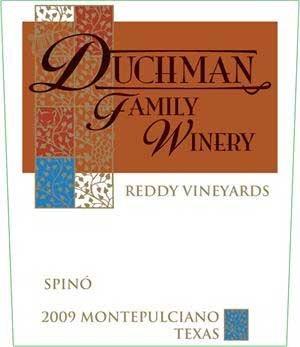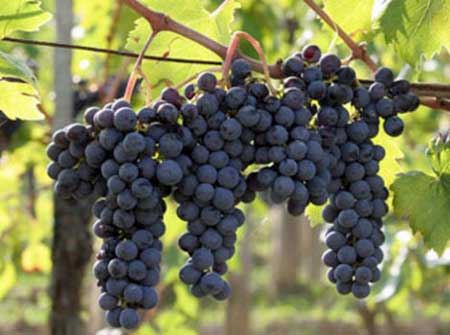It’s Back…I can finally taste wine again, and high time, too! Duchman Spino Montepulciano is here.
Finally, I can say my taste buds are back and in shape again. It’s be a long hard month or more. It all started on February 13th, Valentine’s Day eve. I knew the feeling in the back of my throat that traveled up into my nose and down into my chest. It started four long weeks a winter illness. It was almost three years since I was taken down by a similar cold after a long international flight. This monthlong ordeal included two near recuperations only to be followed by relapse.
At least now, I’m being optimistic since wine is tasting as good as ever, and it’s high time. After the Whole Foods Market Bordeaux Twitter Tasting two weeks ago, I roamed the store more or less in a antihistime-induced daze. While passing though the wine section, I found a bottle of Duchman Family Winery 2009 Spino Montepulciano. But, I didn’t open it then as I would have really enjoyed it.. I knew from my Bordeaux tasting experience that evening that my senses at that time indicated to me a close affinity between wine and battery acid.
The opportunistic find of the Duchman Montipulciano made me think again about what an opportunistic time it is in Texas for wine. We now have the opportunity to sample and taste many new wines grown and produced in Texas that are “outside the box” of the standard California set of Chardonnay, Cabernet and Merlot. But, why Montepulciano?
The Montepulciano grape is widespread across much of Italy. It’s widely planted throughout central and southern reaches of the country, most notably in Abruzzi, Latium, Marche, Molise, Umbria and Apulia, and is a permitted variety in DOC wines produced in 20 of Italy’s 95 provinces particularly those in the south characterized as warm wine growing areas. Under these conditions, Montepulciano can produce deeply colored and well extracted wines, with moderate acidity and reasonable alcohol levels.This makes it one of the most adaptable of Italian red grape varieties. However, it ripens late and is thus not suitable for the cooler northern regions of Italy. Well, Piedmonte’s loss is our gain! This imprecisely why the Montepulciano grape was brought to Texas: the quest for grapes that are better adapted to grow under the warm Texas sun.
There’s another interesting aspect of the Montipulciano grape. It’s confusion.
Montepulciano is the name of both a grape variety and a town in Tuscany. This can cause problems as the wine and the town are not connected. There is a red wine called Vino Nobile di Montepulciano which is in fact made from the Sangiovese grape variety around the town of Montepulciano in Tuscany. Montepulciano the grape variety has its most noteworthy expression is in the wine Montepulciano d’Abbruzzo from the mountainous region of Abruzzi on the Adriatic coast of Central Italy.
Montepulcianos are typically full bodied with deep colour, spicy and dark fruit flavors.They can improve with some bottle age, but as young wines made in a new world, fruit-forward style, they can be great accompaniment to pasta, particularly if it’s pasta made with a deep rich red tomato sauce. They also work well with hearty Italian cuisine or with hard and flavorful cheeses.
In this case, the Duchman Montipulciano was as promised: dark, well extracted and crisp with acidity. It was near opaque from the presence of dark purple pigment extracted from the ripened grapes. The Duchman Montepulciano had plentiful dark fruit flavor that landed on my palate in the vicinity of ripe red-meat, black-skinned plum and was accompanied with a pleasant aromatic, floral note on the nose and lingering spicy finish. It paired well with my pasta with red sauce with mushrooms and garlic, but would have also worked well with a mixed grill of chicken, quail and Italian pork sausage. I guess I need another bottle for that.
Here are some addition details on the Duchman Montepulciano:
Vineyard: Reddy Vineyards located in Brownfield, Texas. The elevation of Reddy Vineyards is 3300 feet. The soil structure of the vineyard is red sandy loam top soil with moisture retaining limestone sub-soil. For list of grapes grown at Reddy Vineyards, click here.
Appellation: Texas High Plains AVA
Bottled: July 2010; total production: 800 Cases
Aging: Fermented in temperature controlled stainless steel tanks and aged in American and French Oak for 9 months. Alcohol %: 12.5



bet you that not many know the reason for the name Spino’ on the label
Please enlighten.
The only connection I have to “Spino” was the Italian family by that name that lived down the street from us when I was growing up.
Despite the fact that they lived five houses down the street, we could still hear their highly spirited family “discussions” that seemed to occur with regularity and with the volume turned to max.
Russ
Russ,
I am very happy that you were able to taste and review our 2009 Montepulciano! This is the first vintage in which the single vineyard “Reddy Vineyards” designation appears on the label. We are extremely proud to be able to support our fantastic growers in such a way. Don’t forget that the 2009 Montepulciano is also served on Tap at the downtown Austin Whole Foods, a first for any wine grown or made in Texas. If you like to 2009, then you’ll love the 2010, which was harvested very late for Texas standards on October 8th 2010. The extra hang time led to amazing aromatics and flavor nuances, but alcohol levels remained very much in check as is our preferred style. Thanks for the kind words.
Bill Elsey
Duchman Family Winery
Now that Alfonso has prompted the question “Why Spino?”, please advise as it has piqued my curiosity.
Glad to be able to taste again….I’m backlogged on my tasting/evaluation activities. The 2009 Duchman Montepulciano is an interesting wine and I hope many get the opportunity to try it.
The appellation for the Reddy vineyards is Texas South Plains, isn’t it?
The Appellation for Reddy VIneyards is Texas High Plains AVA which is a portion of the southern plains that are of sufficient elevation. Details can be found at:
http://txwineregions.tamu.edu/highplains_tech.htm
You can also find information on the other Texas AVAs.
Russ
Great site reference. Thanks!
You talk an awful lot about Duchman wines. Are they paying you to write about there wines? You know there are other wineries in the state right?
Good laugh! No, I’m not paid by Duchman Family Winery to write about them. I write about what I like and they are doing some exciting things to explore what the Texas terroir can delivery with a variety of Tex-Med grapes that appear to be well suited for the environment we have to work with in Texas.
They are also only one of many that I’ve featured. Others are Sandstone Cellars, Becker, Haak, Barking Rocks, McPherson, Kiepersol and Llano Estacado to name just a few.In addition, I typically write about wines of Texas Appellation which narrows down the list a bit, too.
By the way, have you tried Duchman wines. What do you think about them?
Hi, We have a vineyard in Arizona’s Central Highlands north of Prescott. We were thinking of planting some Montepulciano vines and wonder if you could tell us how big is the cluster is, how tannic is the wine and when does it ripen for you. We are at 4550′, 3300 GDD with dry summers.
Thanks so much for you help and advise
I would gladly share a bottle of Duchman Montepulciano with my friends on a Friday evening.